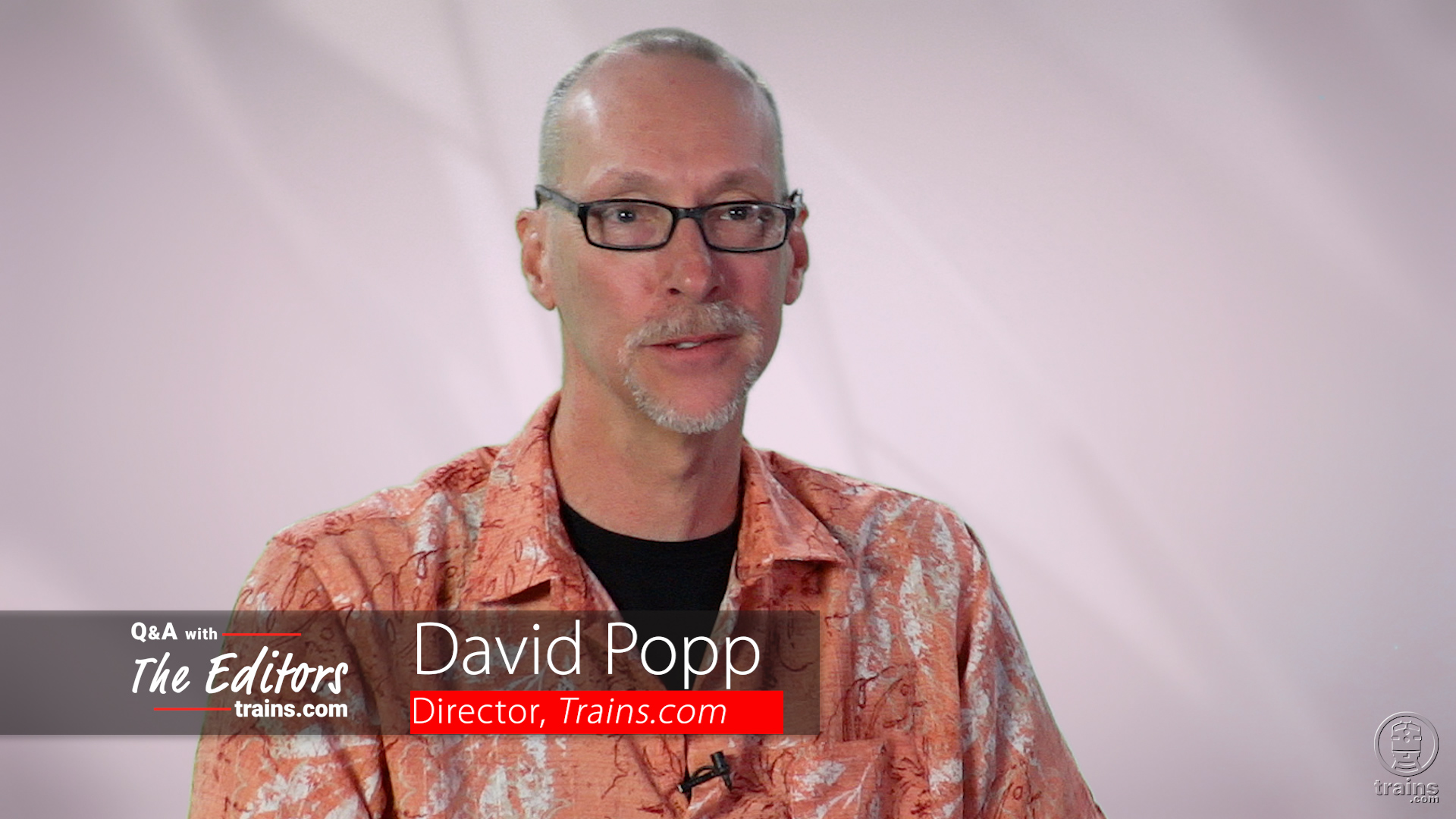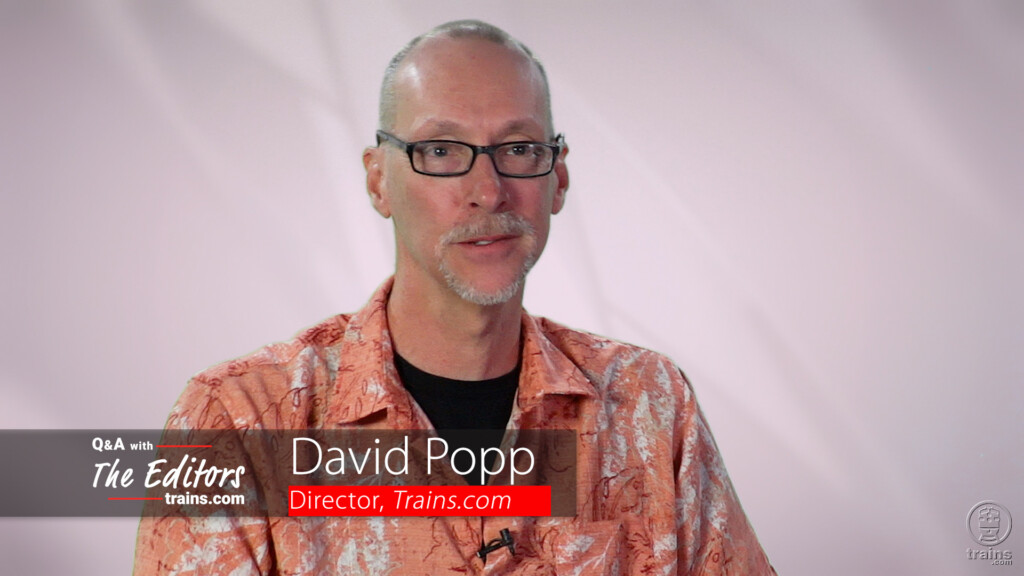Meet David Popp, Trains.com Director in this Q&A with the Editors. Trains.com Unlimited Members can see the video in the Trains.com Video section.

Steve Sweeney: Ladies and gentlemen, welcome to another episode of Q&A with the Editors. We are delighted to have David Popp with us today. David, welcome.
David Popp: Thank you, Steve.
SS: Would you introduce yourself with your title and tell us how you came by working at Kalmbach?
DP: My title is Director of Trains.com, and I came to work for Kalmbach because I applied for the job. There’s a funny story that goes with that in the fact that I’ve been a high school English teacher for several years and was looking for a change. You do something for seven years, it’s time to switch it up.
At the time, a good friend of mine was having his layout featured as the cover story for Great Model Railroads. He came up here to meet with Rick Johnson, who was the long-time illustrator, to go over the track plan and make any little corrections and asked if I wanted to come with him. Since it was summer and I wasn’t teaching at the time, I thought, “Yeah, it’d be great to see the offices of Model Railroader magazine.”
Rick was a very gracious host. He took us all over the building and we got to see everything, including the Milwaukee Racine & Troy. We were looking at the Skyridge high bridge and I just casually asked Rick, “What does it take to work here?”
He answered, “Well, you have to apply.”
SS: And I can just hear it in Rick’s deadpan voice too.
DP: Exactly. So, I applied. Unfortunately, I signed my teaching contract that summer to go back in the fall. Kalmbach called me on the day of the homecoming parade in September. Now, this was in 2001 and a week after September 11th, so the world was crazy to begin with. They called to say that they had an opening and would be interested in interviewing me. I explained to them, being a high school teacher, that there was no way I could just take a day off to visit.
Illinois had Casimir Pulaski Day on the first Monday in March with schools off that day. I took that day to come up here and did a six-hour interview session. Within a couple of days, Kalmbach offered me the job and it was another six weeks before I could get out of my teaching contract and everything else. I was directing the musical South Pacific that year, and couldn’t just walk away.
Fortunately for me, they found a teacher who had just finished his teaching certificate that summer but wasn’t picked up for a fall job. He came on board and I spent several weeks getting him up to speed to transition everything off. As far as I know, he’s still teaching at the high school.
SS: So for the both of you, you got sunlight on the sand and moonlight on the sea. David, we have five standard questions that we try and ask everyone. The first one is, what is your favorite railroad present or past, and why?
DP: That’s a tough question because that changes regularly.
Part of the fun of working here is that I’ve gotten to do different things like design project railroads, and one of the greatest things about working in this building is the library. Being a former teacher, having a library was always nice. But coming to work here with an amazing, probably the second-best railroad library in the United States that’s just down the hall from us, on any given day, I can walk down there and pull up a file cabinet of a railroad I’ve never even heard of before. That sends me on all sorts of little rabbit trails of: “Hey, let’s research this! Hey, let’s find this out! Hey, let’s see where this comes from!” It’s wonderful.
So, I have a lot of favorite railroads. But obviously, I’ve built layouts for the New Haven. I’m still collecting New Haven equipment with the idea that maybe someday I’ll build another New Haven layout. Also, Soo Line was and still is a big favorite of mine. There’s a funny little story that goes with that. My wife and I were on our honeymoon in Colorado and we stopped at the Colorado State Railroad Museum. I’m in the bookstore and found this wonderful book on the Soo Line. It was Wallace Abbey’s The Little Jewel, and I just couldn’t put it down. It mostly has black-and-white photos. But at the same time, Abbey worked for the Soo and was a former Trains staff member. So, he just had a wonderful way of describing this railroad that made me think, “Oh my gosh, this is cool.”
So I got an interest in that from there and it’s just been kind of a lifelong thing. I gained friends through the New Haven Historical Society and the Soo Line Historical Society. Both railroads kind of share a common red, white, and black color scheme, too. There’s a lot to be said there.
SS: David, what is the best part about what you do?
DP: I would say the best part about what I do is that on almost any given day, it’s different. I’m not one of those people that handle routine jobs very well, such as working in manufacturing where it’s putting the same stuff together every single day. I can’t hack that for very long.
This job is all about a change of pace. On any given day, I could be in meetings, planning a new product, or coming up with ideas for the cover of a magazine. I’m then moving over to shooting video, editing something – whether it’s for a magazine or video – and either working on Trains.com or marketing. It’s always something different, and that to me makes it an ideal job.
I tell most people that I have what I call a pinch-me job, and that I come to work every day and go, “Oh my gosh, I get to do this.” It’s not I have to go to work today, it’s I get to go to work today. There’s something to be said for the last 21 years to be able to work at a job where I can say: “I get to go to work today and I get to go do this, or I get to go make videos, or I get to go visit these awesome train layouts.”
Lots of very cool things, and this job never quits in amazing me.
SS: Do you have a favorite moment from all those years?
DP: Yes, I do. For those who’ve followed my career here, I came into MR as an Associate Editor, worked up to Senior Editor, and then Managing Editor for five years. Kind of doing the day-to-day, run-the-ship sort of thing. I switched over to MR Video Plus. We then launched Model Railroading: The Ultimate Guide as a sales piece for Video Plus by taking the videos and reverse-engineer them back into magazine articles with the idea that people would pick up the magazine and go, “Hey, I want to check out these videos and go subscribe to Video Plus.” That Ultimate Guide is still going on, amazingly enough. We’re just wrapping up the fifth installment.
From that, the coolest thing I ever did was being invited to go to Quad Graphics where they printed the first issue. We got to film there when it was on press and just stood there on the machine watching the pages zip by. Pages that we had worked on, in some cases a couple of years’ worth because we had made the videos, turned them into articles, and got it all into print manner.
SS: That’s just amazing.
DP: It was amazing. As a matter of fact, I ran across photos of that on my phone the other day. We shot video there and everything else. Yet, Kent, Ben, and I never did anything with it because it was sort of like we couldn’t improve on the moment. We could have made a video to show you about it. But at the same time, it was like, “That was an experience, and we’ll just leave it as it is.”
But that was cool.
SS: David, what interests you most about what we do at Kalmbach? And let me categorize this: We have research in the library, we can do modeling, we can ride on real trains, we can do train travel. There are a lot of things that we get to do here. Of all those things we get to do, what among them is your favorite thing or what do you seem to like to do most?
DP: Oh, I can tell you right off the top of my head, we make stuff. We make physical things like magazines and articles. We make little more intangible things like videos and stuff that we produce on the Internet. But then, we also get to build models, we get to make model railroads and we get to come up with new ideas for products, whether or not you, I, or other people in the building actually make those products. In my mind, it’s the entire package of creation. We are creating stuff. I love that. That to me is the ideal gig.
SS: In the last question and the most fun. If you were working for the railroad, what railroad craft or position best describes you?
DP: I’m the surveyor. I’m the guy that goes out looking for: Where do we go next? What do we have to pass through? How do we get there? How do we do that?
Without a doubt, I’m always looking for where we take this next and what we do with it. Trains.com is a good example of this, and the beauty part of that is we launch the product but continue adding to it. We’ve added Trains.com Video and continue adding other pieces. We want to expand the archive and make it bigger to include things that we don’t already have in there. To go beyond the core magazines and incorporate all of that stuff, there’s just so much there we can do.
Yet, while everybody says, “Print is dead,” print is not dead. We’re still making lots and lots of great print products with people out there buying and reading them. I enjoy them very much myself. I love charting out the new territory saying, “Okay, guys, get your pickaxes. We’re going that way.”
Going through that rock wall.
SS: David, thank you so much for spending some time with us today.
DP: Thanks for having me, Steve.
SS: Before I let you go, is there anything that you’d like to reiterate, or anything that you’d just like to add to our conversation?
DP: I can tell you I feel truly blessed to get to come and work at Kalmbach. I love teaching, don’t get me wrong, and being actively involved in the education of young people to help them learn about life and growing up. But from what I’ve described here: Being able to create things every day, being excited every day to walk in the door and do something new, and try something new.
The other thing too is that the people that I work with are fabulous. We’ve got people from all different walks of life here with all sorts of different experiences. Some days can be a little contentious. But, where are you not going to find that? It’s like a family, and families are like that too. But, I enjoy it very much and feel blessed to have been chosen by Kalmbach to come work here.
SS: Fantastic. David, thank you.
DP: Thanks, Steve.

